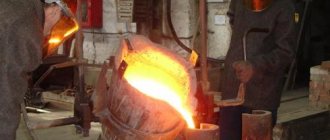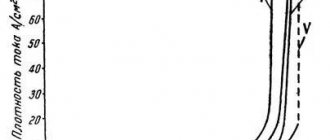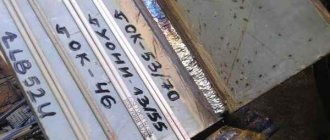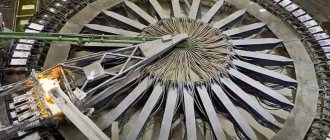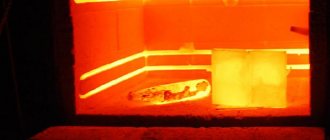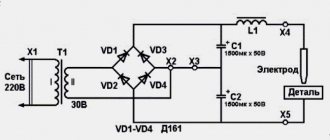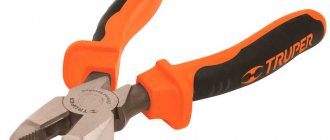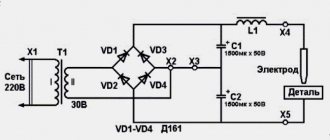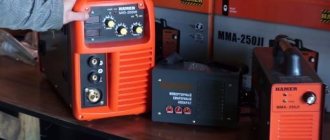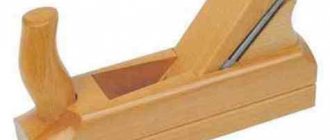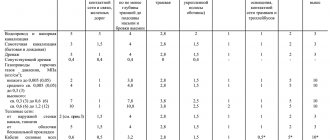Types of produced white cast iron
Depending on the crystalline structure, as well as the presence and ratio of the constituent elements, white cast iron is divided into:
- ordinary;
- alloy;
- heat resistant;
- stainless.
A separate type is cast iron alloys with high electrical resistivity.
The internal structure of ordinary white cast iron contains carbon in the form of cementite grains. The amount of carbon affects the melting point and, depending on this, cast iron is divided into:
- hypoeutectic with a lower melting point, carbon not more than 4.3%;
- eutectic with a carbon content of 4.3%;
- hypereutectic – more than 4.35% and can reach – 6.3%.
The effect of cast iron bleaching is achieved by rapidly cooling the casting, which as a result is heterogeneous in composition. The top layer, up to 30 mm thick, becomes white, and the rest of the core is ordinary gray cast iron.
Advantages and disadvantages
Like all cast iron alloys, white ones are distinguished by great strength combined with brittleness under strong mechanical shocks. Among the main positive qualities of white cast iron are:
- high hardness;
- high resistivity;
- wear resistance;
- increased corrosion resistance.
An important quality of white cast iron is considered to be very good resistance to high temperatures, which is used to reduce the number of cracks in initial castings.
The main disadvantages include such qualities as:
- fragility and the possibility of destruction under mechanical stress;
- low casting qualities and poor mold filling;
- the likelihood of internal cracks forming during casting;
- complex and low-quality mechanical processing.
Formation of defects during welding due to the rapid burnout of carbon and the formation of pores.
Application area
Ordinary white cast iron is used very limitedly, since it is poorly applicable to mechanical and heat treatment. For the production of products it is often used in the form of unprocessed or partially processed castings.
The alloy is most widely used in the manufacture of large parts of simple configuration. These are housings and parts of machine tools and rolling mills, balls for mills, drive and support wheels. In addition, white cast iron is used for the manufacture of assembly units that are constantly exposed to abrasive materials.
An important point is the use of ordinary cast iron as a raw material for the manufacture of malleable grades of iron-carbon cast iron and steel alloys.
Malleable iron
It is known that such car parts as wheel hubs and differential housings experience dynamic loads. Can cast iron be used to make them? It is possible if its plasticity is significantly increased. Malleable cast iron has this property , in which the graphite has a flake-like rather than a lamellar shape. Compared to gray cast iron, ductile iron has a lower concentration of graphitizing elements - carbon and silicon.
Malleable cast iron is superior to gray cast iron in terms of strength and ductility. Changes in the chemical composition have led to a decrease in fluidity and an increase in shrinkage during solidification, which requires the installation of profits even on small castings. The production of malleable iron usually uses the duplex process.
Cast iron is smelted into a cut, then transported in a transfer ladle and poured into an electric induction furnace, where it is heated before pouring to increase fluidity.
The technological process for producing castings from malleable cast iron is similar to producing castings from gray cast iron. Automatic molding lines are becoming increasingly common. Metal is poured into molds on a conveyor belt. The castings produced must have a white cast iron structure throughout their entire cross-section. To obtain the structure of malleable cast iron, they are subjected to graphitizing annealing in thermal furnaces. During the holding period, white cast iron cementite decomposes and flake-shaped graphite inclusions are formed. After heat treatment, the castings are straightened on special presses.
The need to use long-term heat treatment and straightening significantly increases the complexity of manufacturing parts made of malleable cast iron. The forged steel blank of an engine camshaft is noticeably different from the finished part.
The cast billet is much closer in configuration to it, which greatly reduces the complexity of machining. The same applies to crankshafts, critical parts. To replace forged blanks with cast ones, an alloy is needed that would combine the mechanical properties of steel with the technological and operational properties of cast iron.
Alloying of white cast iron
The presence of alloying additives in the alloy greatly changes its physical properties, which significantly expand its scope of application. Very common substances are used as alloying elements in metallurgy.
To increase hardness, the following can be added to an iron-carbon cast iron alloy: nickel, phosphorus, manganese, chromium, vanadium, silicon, copper, titanium and sulfur.
In the event that the amount of alloying additives is approximately equal to the carbon content, cast iron acquires the maximum possible hardness.
Wear resistance, as a physical characteristic of white cast iron, is considered regardless of its hardness. Its increase is achieved by changing the structure of the metal by adding carbides and phosphides in the form of evenly distributed inclusions. The quality of casting parts directly depends on the chemical composition of the alloys and the amount of alloying elements.
Read also: Homemade equipment for the garage
Depending on the percentage of alloying impurities, white cast iron is divided into:
- low alloyed up to 2.5%;
- medium alloyed up to 10%;
- highly alloyed.
Already finished cast iron castings are subjected to additional temperature treatment (annealing), as a result of which the internal stresses of the metal are relieved and the external dimensions are stabilized. The annealing temperature of white alloy cast iron is about 850°C.
The heating and cooling process occurs slowly to prevent the formation of internal cracks and other defects.
Alloy cast iron alloys are widely used in production:
- parts of industrial equipment and machine tools;
- components and parts of cars, tractors and agricultural machinery;
- rolling stock; pipes, pumps, boilers;
- household and household products.
This is due to the improved qualities of the metals compared to ordinary white cast iron.
Which is better – gray or white cast iron?
So, “gray” is fluid, durable and mechanically stable, but is easily damaged by cutting and does not always withstand impact loads. White, in turn, on the contrary, is practically not damaged by cutting, but at the same time it is very fragile, not plastic, not fluid and, in principle, is not used in its pure form.
But the difference between the materials does not stop there.
| Variety | Grey | White |
| Carbon content and form | Up to 3.5% as graphite | Up to 3.8% as cementite (Fe3C compound) |
| Useful impurities | Silicon (up to 2.5%), manganese (up to 0.8%) | No |
| Mechanical strength (ability to withstand single shock loads) | High (but not enough for the production of “critical” structural components) | Low |
| Fragility (how high is the risk of splitting upon impact or temperature change) | Average | High |
| Hardness (ability to withstand cutting loads) | Average | Maximum among all cast iron alloys |
| Flowability (ability to take complex shapes when casting) | High | Low |
| Compression resistance | High | Low (due to fragility) |
| Plasticity (the ability to deform during forging or constant mechanical loads) | Average | Low |
| Wear resistance (the ability to maintain shape and performance under constant, periodic or regular shock loads) | Above average | Low |
In general, white cast iron is practically not used in the production of final products. It is a raw material for other alloys, including steel. But gray is used quite widely. But in the domestic sphere it is easier to “meet” alloyed or specially prepared ones - for example, high-strength, anti-friction or malleable cast iron.
Stainless alloys
To increase the resistance of white cast iron to corrosion, large amounts of chromium are added to it. This leads to the formation of an oxide film on the surface and further cessation of oxygen access. In addition, high-chromium white cast iron becomes resistant to alkaline solutions, sulfuric and nitric acid.
Additionally, the process of alloying with chromium prevents the possibility of coagulation of carbides when the alloy is heated strongly. This allows you to obtain high-quality welded joints of parts made of white cast iron. If nickel and molybdenum are added along with chromium during the alloying process, the resulting stainless alloy can be compared in strength to the best heat-resistant steels, which are much more expensive.
Chromium-containing white cast iron is used in cases of severe operating conditions, the presence of alkalis and oxidizing agents, and the need for high electrical resistance.
High resistivity alloys
These types of white cast iron are used for the manufacture of cast heaters for electric furnaces and dryers operating at temperatures up to 900°C. To obtain the alloy, add to it:
Such white cast iron with high resistivity is called sormite and is used for the manufacture of electric heaters of various powers.
White cast iron cannot be called a very common alloy due to technical difficulties in its mechanical and heat treatment. However, the creation of alloyed alloys significantly expands the scope of application of this material as a result of a fundamental change in its physical and chemical properties.
Moreover, the alloying process does not require the use of rare and very expensive additives. Therefore, the use of white cast iron for the manufacture of products and workpieces will expand.
Iron-carbon alloys containing more than 2% are called cast iron. carbon. Cast iron has lower mechanical properties than steel, but is cheaper and can be cast well into products of complex shapes. There are several types of cast iron. White cast iron,
in which all carbon (2.0.3.8%) is in a bound state in the form of Fe3C (cementite), which determines its properties: high hardness and brittleness, good wear resistance, poor machinability with cutting tools.
White cast iron is used to produce gray and ductile iron and steel. Gray cast iron
contains carbon in a bound state only partially (no more than 0.5%).
The rest of the carbon is in the cast iron in a free state in the form of graphite. Graphite inclusions make the fracture color gray. The darker the fracture, the softer the cast iron. The formation of graphite occurs as a result of heat treatment of white cast iron, when part of the cementite breaks down into soft ductile iron and graphite. Depending on the predominant structure, gray cast iron is distinguished on a pearlitic, ferritic or ferrite-perlite basis. When iron-carbon alloys are slowly cooled, graphite precipitates. Gray cast iron is widely used in mechanical engineering, as it is easy to process and has good properties. Depending on the strength, gray cast iron is divided into 10
grades (GOST 1412).
Gray cast irons, with low tensile strength, have fairly high compressive strength. Gray cast iron contains carbon – 3.2…3.5%
;
silicon – 1.9…2.5%
;
manganese – 0.5…0.8%
;
phosphorus – 0.1…0.3%
; sulfur – Page 4 of 10 4 5 6 7 8 9 10
Read also: Cordless vacuum cleaner for stairs
To continue downloading you must pass the captcha:
Free job cost estimate service
- Fill out the application. Specialists will calculate the cost of your work
- Cost calculation will be sent by email and SMS.
Your application number
Right now you will receive an automatic confirmation email with information about your application.
White cast irons: composition, properties, scope.
Carbon is in the form of cementite Fe3C. The break will be white if broken. In the structure of hypoeutectic cast iron HB 550, along with pearlite and secondary cementite, there is brittle eutectic (ledeburite), the amount of which reaches 100% in eutectic cast iron. The structure of hypereutectic cast iron consists of eutectic (Ep) and primary cementite, which is released during crystallization from the liquid in the form of large plates. High hardness, difficult to cut. Ch. property: high wear resistance. Cast iron is brittle. Rarely used in mechanical engineering. It is used in the manufacture of millstones in mills, rolling rolls in rolling machines, and fences are made from this cast iron. If the casting is small (up to 10 kg), then white cast iron is formed during rapid cooling.
Preparation: Three types of white cast iron are smelted in blast furnaces: foundry coke iron, pigment coke iron and ferroalloys.
The structure does not affect the ductility; it remains extremely low. But it does affect hardness. Mechanical strength is mainly determined by the number, shape and size of graphite inclusions. Small, swirl-shaped graphite flakes reduce strength less. This form is achieved through modification. Aluminum, silicocalcium, and ferrosilicon are used as modifiers.
Gray cast iron is widely used in mechanical engineering, as it is easy to process and has good properties.
Depending on the strength, gray cast iron is divided into 10
brands (GOST 1412).
Gray cast irons, with low tensile strength, have fairly high compressive strength.
Gray cast irons contain carbon - 3,2…3,5 %
;
silicon – 1.9…2.5%
;
manganese – 0.5…0.8%
;
phosphorus – 0.1…0.3%
; sulfur –
They are designated by the index SCh (gray cast iron) and a number that shows the value of the tensile strength multiplied by 10 -1 SCh 15.
Preparation: Graphite is formed in gray cast iron as a result of the decomposition of brittle cementite. This process is called graphitization. The decomposition of cementite is caused artificially by introducing silicon or special heat treatment of white cast iron.
High-strength nodular cast iron.
High-strength cast irons (GOST 7293) can have a ferritic (VCh 35), ferrite-pearlite (VCh 45) and pearlitic (VCh 80) metal base.
These cast irons are obtained from gray cast irons as a result of modification with magnesium or cerium (added 0,03…0,07%
from the mass of the casting). Compared to gray cast irons, the mechanical properties are increased, this is caused by the lack of unevenness in stress distribution due to the spherical shape of graphite.
Cast irons with a pearlitic metal base have high strength values with a lower ductility value. The ratio of ductility and strength of ferritic cast iron is the opposite.
High-strength cast irons have a high yield strength,
,
which is higher than the yield strength of steel castings. Also characterized by fairly high impact strength and fatigue strength,
,
with pearlite base.
High-strength cast irons contain: carbon – 3,2…3,8 %,
silicon -
1.9...2.6%
, manganese -
0.6...0.8%
, phosphorus - up to
0.12%
, sulfur - up to
0.3%
.
Read also: Steel is an alloy of iron and carbon where
These cast irons have high fluidity, linear shrinkage is about 1%. Casting stresses in castings are slightly higher than for gray cast iron. Due to the high modulus of elasticity, the machinability is quite high. They have satisfactory weldability.
High-strength cast iron is used to make thin-walled castings (piston rings), forging hammers, beds and frames of presses and rolling mills, molds, tool holders, and faceplates.
Crankshaft castings weighing up to 2..3
t, instead of forged steel shafts, they have higher cyclic toughness, are insensitive to external stress concentrators, have better anti-friction properties and are much cheaper.
They are designated by the index HF (high-strength cast iron) and a number that shows the value of the tensile strength multiplied by HF 100.
Preparation: High-strength cast iron (GOST 7293-79) is a type of gray cast iron that is obtained by modifying it with magnesium or cerium. The graphite inclusions in these cast irons are spherical in shape.
Produced by annealing white hypoeutectic cast iron.
Good properties of castings are ensured if graphitization does not occur during the process of crystallization and cooling of the castings in the mold. To prevent graphitization, cast irons must have a reduced carbon and silicon content.
Malleable cast irons contain: carbon – 2,4…3,0 %
, silicon -
0.8...1.4%
, manganese -
0.3...1.0%
, phosphorus - up to
0.2%
, sulfur - up to
0.1%
.
The formation of the final structure and properties of castings occurs during the annealing process, the diagram of which is presented in Fig. 11.4. Castings are kept in an oven at a temperature of 950...1000C
within
15…20
hours.
Cementite decomposes: Fe3C→Fey(C)+C .
The structure after exposure consists of austenite and graphite (annealing carbon). With slow cooling in the range of 760...720 o C
, decomposition of cementite, which is part of pearlite, occurs, and the structure after annealing consists of ferrite and annealing carbon (ferritic malleable cast iron is obtained).
With relatively rapid cooling (mode b, Fig. 11.3), the second stage is completely eliminated, and pearlitic malleable cast iron is obtained.
The structure of cast iron, annealed according to the regime in,
consists of pearlite, ferrite and annealed graphite (ferrite-pearlite malleable cast iron is obtained)
In terms of mechanical and technological properties, malleable cast iron occupies an intermediate position between gray cast iron and steel. The disadvantage of malleable cast iron compared to high-strength cast iron is the limited wall thickness for casting and the need for annealing.
Ductile iron castings are used for parts operating under shock and vibration loads. Gearbox housings, hubs, hooks, brackets, clamps, couplings, and flanges are made from ferritic cast iron.
Pearlitic cast iron, characterized by high strength and sufficient ductility, is used to make driveshaft forks, links and rollers of conveyor chains, and brake pads.
They are designated by the index KCh (high-strength cast iron) and two numbers, the first of which shows the value of the tensile strength multiplied by , and the second - the relative elongation - KCh 30 - 6.
Preparation: Malleable cast iron is a type of gray cast iron obtained by long-term (up to 80 hours) holding white cast iron at high temperatures. This heat treatment is called simmering. In this case, cementite disintegrates and the graphite released during its decomposition forms flocculent inclusions. Depending on the temperature and duration of aging, malleable cast irons are produced on ferritic and ferrite-pearlite bases.
Didn't find what you were looking for? Use the search:
Best sayings:
A student is a person who constantly postpones the inevitable.
10178 – | 7215 – or read all.
Gray cast iron
Despite its relatively low mechanical properties, gray cast iron is widely used. Because it is easy to process, has increased damping capacity, as well as anti-friction properties. Because the graphite of cast iron holds the lubricant and itself serves as a lubricant. The mating cast iron parts move easily relative to each other.
Gray cast iron with small additions of chromium and nickel acquires good elastic properties. A piston ring made of such cast iron, after removing the load, returns to its original dimensions.
Gray cast iron has high fluidity. At real pouring temperatures, the length of a spiral cast iron sample is almost twice as long as a steel one, which makes it possible to produce castings of complex configurations.
Gray cast iron is characterized by low volumetric shrinkage during crystallization, allowing in many cases to dispense with installation and profit. The most common unit for smelting gray cast iron is a cupola with a dripper, in which metal accumulates, as well as its composition and temperature are averaged. To reduce the tendency of cast iron to chill, it is modified by introducing silicon-containing additives into the liquid metal. Modification allows you to equalize the properties of the metal in different sections of the casting. This can be seen from the example of measuring the hardness of cast iron. Unmodified and modified.
The chill depth on a wedge sample of modified cast iron is significantly less than that of unmodified cast iron. The shape of graphite inclusions also changes as a result of modification.
In addition to cupola furnaces, electric furnaces . They allow metal to be smelted at a higher temperature, which is important for subsequent, out-of-furnace processing of cast iron. Molds for producing castings from gray cast iron are made by compacting the molding sand in flasks. Cores are installed into the mold cavity to perform the internal configuration of the casting.
In mass production, automatic flaskless molding lines , including installation of cores using a core layer.
The metal of the mold is also poured automatically. Gray cast iron castings are made not only in sand molds, but also in metal ones. To produce castings shaped like bodies of rotation, the centrifugal casting method is widely used. At the same time, labor productivity increases, molding materials are not consumed, and there is no gating system.
Gray cast iron is a generally recognized construction material. It is used for the manufacture of various parts operating under conditions of static loads, vibration, and increased friction.
